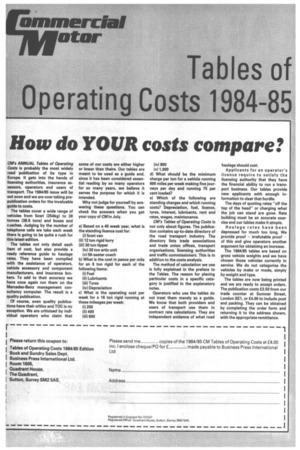Tables of Operating Costs 1984-85
Page 56

If you've noticed an error in this article please click here to report it so we can fix it.
How do YOUR costs compare?
CM's ANNUAL Tables of Operating Costs is probably the most widely read publication of its type in Europe. It gets into the hands of licensing authorities, insurance assessors, operators and users of transport. The 1984/85 issue will be out soon and we are now taking prepublication orders for the invaluable guide to costs.
The tables cover a wide range of vehicles from 5cwt (254kg) to 38 tonnes (38.6 tons) and buses and coaches. Judging by the number of telephone calls we take each week there is going to be quite a rush for this latest edition.
The tables not only detail each item of cost, but also provide a ready reference guide to haulage rates. They have been compiled with the assistance of operators, vehicle accessory and component manufacturers, and insurance brokers. To add to their accuracy we have once again run them on the Mercedes-Benz management consultancy computer. The result is a quality publication.
Of course, even quality publications have their critics and TOC is no exception. We are criticised by individual operators who claim that some of our costs are either higher or lower than theirs. Our tables are meant to be used as a guide and, since it has been considered essential reading by so many operators for so many years, we believe it serves the purpose for which it is intended.
Why not judge for yourself by answering these questions. You can check the answers when you get your copy of CM in July.
(iv) 800 (v) 1,000 d) What should be the minimum charge per ton for a vehicle running 600 miles per week making five journeys per day and running 75 per cent loaded?
e) Which of the following are standing charges and which running costs? Depreciation, fuel, licence, tyres, interest, lubricants, rent and rates, wages, maintenance.
CM's Tables of Operating Costs is not only about figures. The publication contains up-to-date directory of the road transport industry. The directory lists trade associations and trade union offices, transport organisations, licensing authorities and traffic commissioners. This is in addition to the costs analysis.
The method of calculation we use is fully explained in the preface to the Tables. The reason for placing particular costs in a specific category is justified in the explanatory notes.
Operators who use the tables do not treat them merely as a guide. We know that both providers and users of transport use them in contract rate calculations. They are independent evidence of what road haulage should cost.
Applicants for an operator's licence require to satisfy the licensing authority that they have the financial ability to run a transport business. Our tables provide new applicants with enough information to clear that hurdle.
The days of quoting rates "off the top of the head" or charging what the job can stand are gone. Rate building must be an accurate exercise and our tables make it simple.
Haulage rates have been depressed for much too long. We provide proof — irrefutable proof of this and give operators another argument for obtaining an increase.
The 1984/85 tables are based on gross vehicle weights and we have chosen those vehicles currently in service. We do not categorise the vehicles by make or mode, simply by weight and type.
The tables are now being printed and we are ready to accept orders. The publication costs £3.50 from our trade counter at Sumner Street, London SE1, or £4.00 to include post and packing. They can be obtained by completing the order form and returning it to the address shown, with the appropriate remittance.




























































































